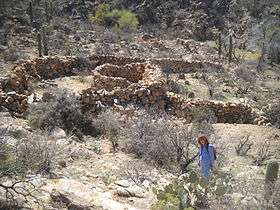Tortolita Mountains
| Tortolita Mountains | |
|---|---|
 Old stone sheep pens in Derrio Canyon, west end of Tortolitas | |
| Highest point | |
| Elevation | 4,696 ft (1,431 m) |
| Coordinates | 32°31.78′N 111°02.44′W / 32.52967°N 111.04067°WCoordinates: 32°31.78′N 111°02.44′W / 32.52967°N 111.04067°W |
| Geography | |
 Tortolita Mountains Tortolita Mountains | |
| Country | United States |
| State | Arizona |
| Region | Sonoran Desert |
| Counties | Pinal and Pima |
| Cities | Tucson |
The Tortolita Mountains are a modest mountain range northwest of Tucson, Arizona, USA, at the northern boundaries of Oro Valley and Marana, two suburbs of Tucson. Peak elevation is 4,696 feet (1,431 m).[1] Much of the mountain range is protected within the Tortolita Mountain Park, established in 1986 by Pima County and slated for further expansion.[2] Public access to the Park, especially from Marana, has become contentious.[3]
The Tortolita Mountains include extensive cultural resources. Native American peoples known as the Hohokam heavily occupied the area for approximately 700 years beginning around AD 500. In the eastern foothills of the Tortolita Mountains are ruins of Honeybee Village, a former Hohokam pueblo preserved and maintained by the Town of Oro Valley. Nearby is Honeybee Canyon, a riparian area with one of Pima County's only perennial streams , Honeybee Creek. Honeybee Canyon has been the source of conflict between environmentalists and real estate developers, beginning in the 1990s. Resorts, golf courses, and upscale homes have been developed near the canyon with significant controversy . Honeybee Canyon Park [4] is a small developed area with restrooms, and is the trailhead for the popular Honeybee Canyon trail.[5]
Other mountain ranges surrounding the Tucson Valley include the Santa Catalina Mountains (the area's most prominent), the Rincon Mountains, the Santa Rita Mountains, and the Tucson Mountains.
References
External links
- Tortolita Mountain Range information on terrain, trails, and hiking